
Medical device company Merit Medical Systems (NASDAQ: MMSI) announced better-than-expected revenue in Q1 CY2025, with sales up 9.8% year on year to $355.4 million. The company expects the full year’s revenue to be around $1.48 billion, close to analysts’ estimates. Its non-GAAP profit of $0.86 per share was 14.8% above analysts’ consensus estimates.
Is now the time to buy Merit Medical Systems? Find out by accessing our full research report, it’s free.
Merit Medical Systems (MMSI) Q1 CY2025 Highlights:
- Revenue: $355.4 million vs analyst estimates of $352.7 million (9.8% year-on-year growth, 0.8% beat)
- Adjusted EPS: $0.86 vs analyst estimates of $0.75 (14.8% beat)
- Adjusted EBITDA: $75.1 million vs analyst estimates of $71.58 million (21.1% margin, 4.9% beat)
- The company reconfirmed its revenue guidance for the full year of $1.48 billion at the midpoint
- Management lowered its full-year Adjusted EPS guidance to $3.36 at the midpoint, a 7.8% decrease
- Operating Margin: 11.5%, in line with the same quarter last year
- Free Cash Flow Margin: 5.5%, down from 7.6% in the same quarter last year
- Organic Revenue rose 6% year on year (7% in the same quarter last year)
- Market Capitalization: $5.54 billion
“We delivered better-than-expected financial performance in the first quarter, with our constant currency revenue, organic, our constant currency total revenue and our non-GAAP EPS exceeding the high-end of our expectations,” said Fred P. Lampropoulos, Merit’s Chairman and Chief Executive Officer.
Company Overview
Founded in 1987 and now offering over 1,700 patented products across global markets, Merit Medical Systems (NASDAQ: MMSI) manufactures and markets specialized medical devices used in minimally invasive procedures for cardiology, radiology, oncology, critical care, and endoscopy.
Medical Devices & Supplies - Cardiology, Neurology, Vascular
The medical devices and supplies industry, particularly in the fields of cardiology, neurology, and vascular care, benefits from a business model that balances innovation with relatively predictable revenue streams. These companies focus on developing life-saving devices such as stents, pacemakers, neurostimulation implants, and vascular access tools, which address critical and often chronic conditions. The recurring need for these devices, coupled with growing global demand for advanced treatments, provides stability and opportunities for long-term growth. However, the industry faces hurdles such as high research and development costs, rigorous regulatory approval processes, and reliance on reimbursement from healthcare systems, which can exert downward pressure on pricing. Looking ahead, the industry is positioned to benefit from tailwinds such as aging populations (which tend to have higher rates of disease) and technological advancements like minimally invasive procedures and connected devices that improve patient monitoring and outcomes. Innovations in robotic-assisted surgery and AI-driven diagnostics are also expected to accelerate adoption and expand treatment capabilities. However, potential headwinds include pricing pressures stemming from value-based care models and continued complexity changing from navigating regulatory frameworks that may prioritize further lowering healthcare costs.
Sales Growth
A company’s long-term sales performance can indicate its overall quality. Even a bad business can shine for one or two quarters, but a top-tier one grows for years. Regrettably, Merit Medical Systems’s sales grew at a mediocre 6.8% compounded annual growth rate over the last five years. This was below our standard for the healthcare sector and is a rough starting point for our analysis.
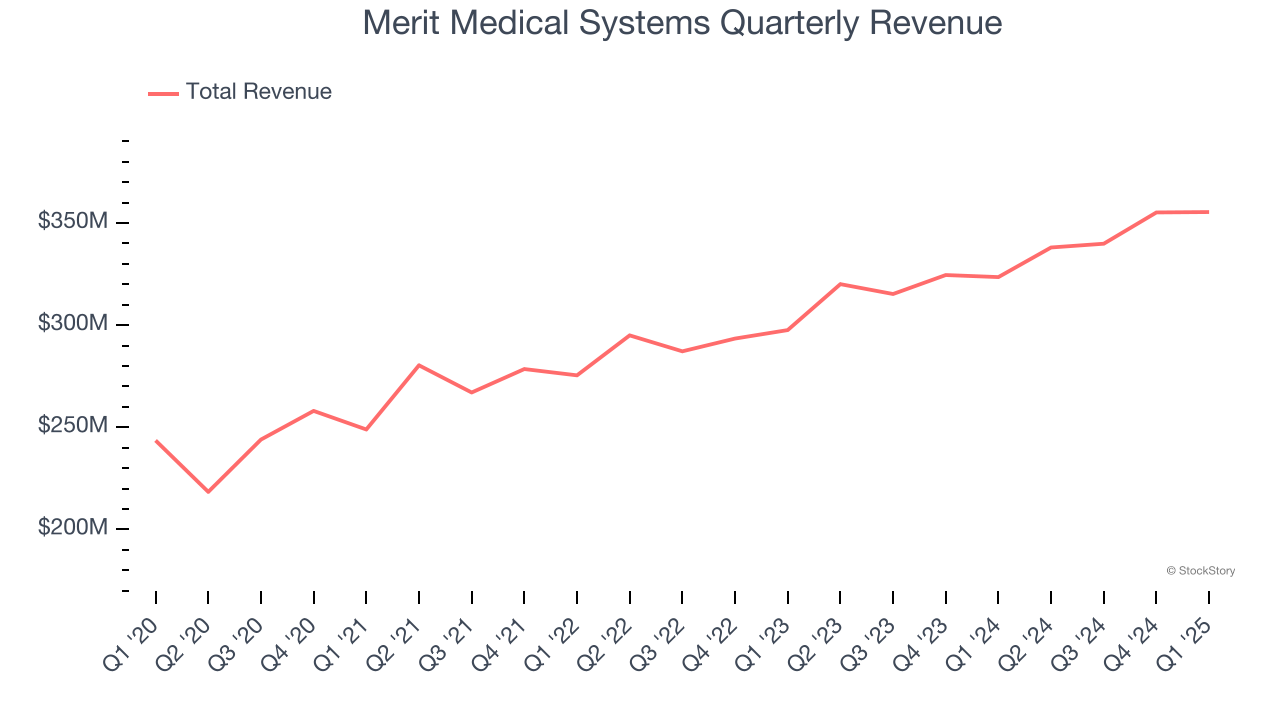
Long-term growth is the most important, but within healthcare, a half-decade historical view may miss new innovations or demand cycles. Merit Medical Systems’s annualized revenue growth of 8.8% over the last two years is above its five-year trend, suggesting some bright spots. 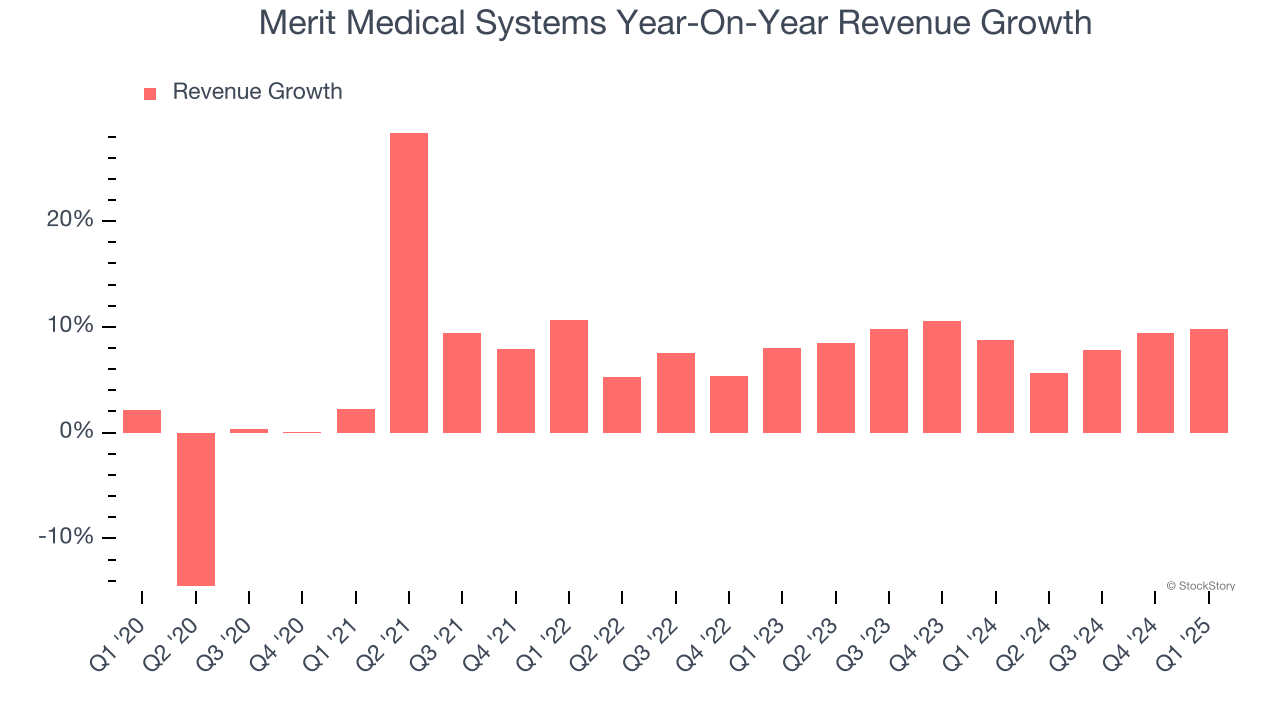
We can better understand the company’s sales dynamics by analyzing its organic revenue, which strips out one-time events like acquisitions and currency fluctuations that don’t accurately reflect its fundamentals. Over the last two years, Merit Medical Systems’s organic revenue averaged 6.8% year-on-year growth. Because this number is lower than its normal revenue growth, we can see that some mixture of acquisitions and foreign exchange rates boosted its headline results. 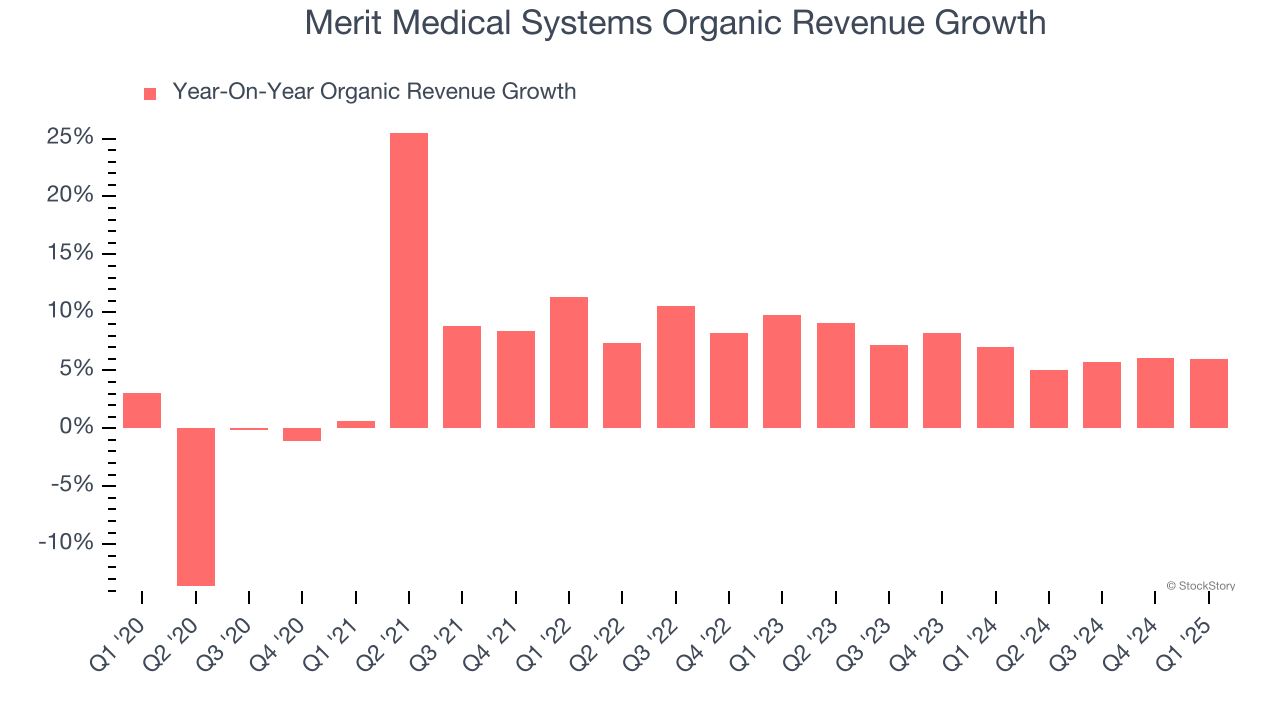
This quarter, Merit Medical Systems reported year-on-year revenue growth of 9.8%, and its $355.4 million of revenue exceeded Wall Street’s estimates by 0.8%.
Looking ahead, sell-side analysts expect revenue to grow 8.1% over the next 12 months, similar to its two-year rate. This projection is noteworthy and indicates the market is forecasting success for its products and services.
Today’s young investors won’t have read the timeless lessons in Gorilla Game: Picking Winners In High Technology because it was written more than 20 years ago when Microsoft and Apple were first establishing their supremacy. But if we apply the same principles, then enterprise software stocks leveraging their own generative AI capabilities may well be the Gorillas of the future. So, in that spirit, we are excited to present our Special Free Report on a profitable, fast-growing enterprise software stock that is already riding the automation wave and looking to catch the generative AI next.
Operating Margin
Merit Medical Systems was profitable over the last five years but held back by its large cost base. Its average operating margin of 7.9% was weak for a healthcare business.
On the plus side, Merit Medical Systems’s operating margin rose by 10.4 percentage points over the last five years, as its sales growth gave it operating leverage. Zooming in on its more recent performance, we can see the company’s trajectory is intact as its margin has also increased by 3.2 percentage points on a two-year basis.
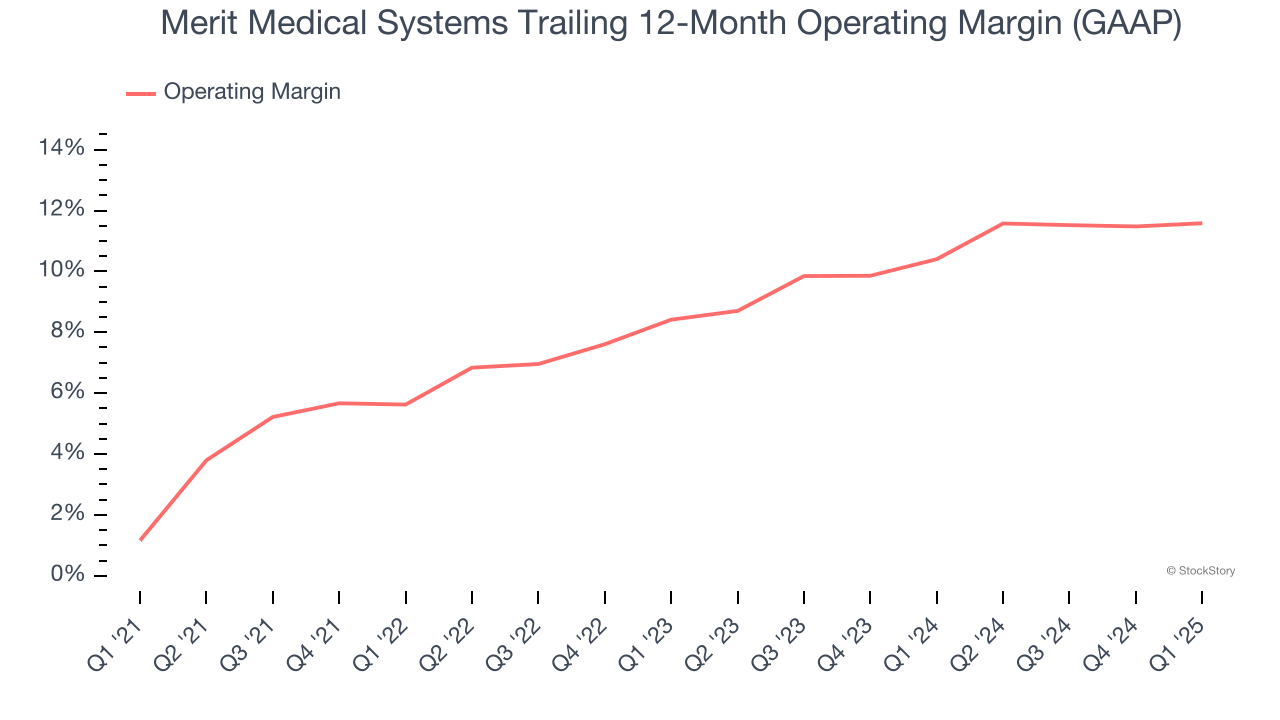
In Q1, Merit Medical Systems generated an operating profit margin of 11.5%, in line with the same quarter last year. This indicates the company’s overall cost structure has been relatively stable.
Earnings Per Share
Revenue trends explain a company’s historical growth, but the long-term change in earnings per share (EPS) points to the profitability of that growth – for example, a company could inflate its sales through excessive spending on advertising and promotions.
Merit Medical Systems’s EPS grew at an astounding 19.2% compounded annual growth rate over the last five years, higher than its 6.8% annualized revenue growth. This tells us the company became more profitable on a per-share basis as it expanded.
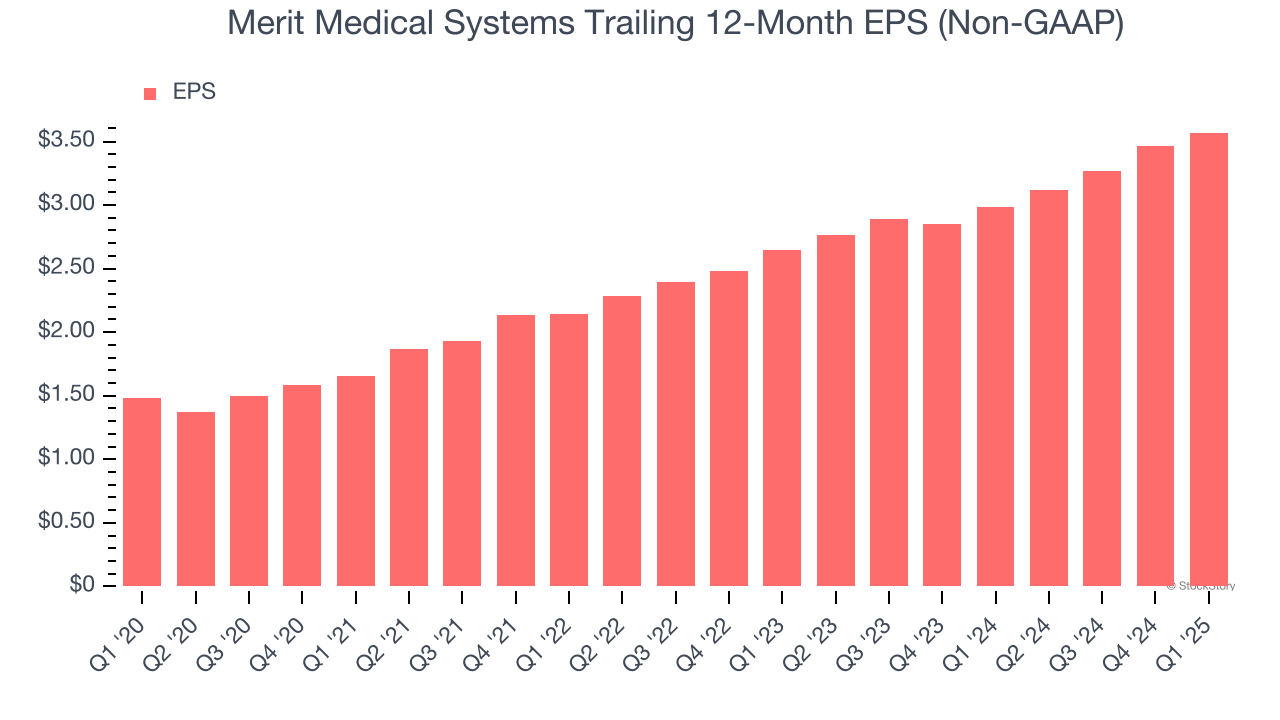
We can take a deeper look into Merit Medical Systems’s earnings to better understand the drivers of its performance. As we mentioned earlier, Merit Medical Systems’s operating margin was flat this quarter but expanded by 10.4 percentage points over the last five years. This was the most relevant factor (aside from the revenue impact) behind its higher earnings; taxes and interest expenses can also affect EPS but don’t tell us as much about a company’s fundamentals.
In Q1, Merit Medical Systems reported EPS at $0.86, up from $0.75 in the same quarter last year. This print easily cleared analysts’ estimates, and shareholders should be content with the results. Over the next 12 months, Wall Street expects Merit Medical Systems’s full-year EPS of $3.57 to grow 4.9%.
Key Takeaways from Merit Medical Systems’s Q1 Results
This was a bit of a messy quarter. On one hand, Merit Medical Systems beat analysts’ organic revenue and EPS expectations this quarter. On the other hand, its full-year EPS guidance was lowered and missed significantly. Zooming out, we think this was a mixed quarter featuring some areas of strength but also some blemishes. The stock remained flat at $94.60 immediately following the results.
So should you invest in Merit Medical Systems right now? When making that decision, it’s important to consider its valuation, business qualities, as well as what has happened in the latest quarter. We cover that in our actionable full research report which you can read here, it’s free.








